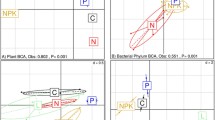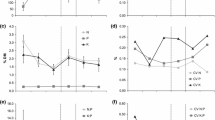Summary
The interactive effects of fertilization and disturbance on plant community structure and resource availability were studied by supplying four levels of nitrogen and applying four intensities of tilling to a 30 year old field in a factorial design for 2 year. Live above-ground biomass, root biomass, and litter generally increased with nitrogen supply and decreased with disturbance. Species composition varied significantly, with annuals increasing with both nitrogen and disturbance, but with perennials unaffected by nitrogen and decreased by disturbance. Species diversity decreased with disturbance, but decreased with nitrogen only in undisturbed vegetation. Root: shoot ratios decreased with added nitrogen, leaf allocation decreased with disturbance, and flowering allocation increased. Surprisingly, stem allocation was unaffected by disturbance. This result reflected a shift from vertical stems to horizontal stems as disturbance increased. Resource measurements suggested that the vegetation responded to interactions between the treatments as well as to direct treatment effects. Variation in light penetration was reduced by fertilization in undisturbed vegetation but not in tilled plots; variability was not directly affected by disturbance. The availability of nitrogen, the limiting soil nutrient, increased with fertilization but was not significantly affected by disturbance. In contrast, the ratio of ammonium to nitrate was significantly reduced by disturbance but unaffected by supply rates, suggesting that nitrogen may have had different effects under different disturbance regimes, even though its total availability was constant. While many community responses to fertilization and disturbance conformed to those reported earlier, resource and allocation measurements indicated that their interactions are not always predictable from their separate effects.
Similar content being viewed by others
References
Armesto JJ, Pickett STA (1985) Experiments on disturbance in old-field plant communities: impact on species-richness and abundance. Ecology 66:230–240
Campbell BD, Grime JP (1989) A comparative study of plant responsiveness to the duration of episodes of mineral nutrient enrichment. New Phytol 112:261–267
Carson WP, Pickett STA (1990) Role of resources and disturbance in the organization of an old-field plant community. Ecology 71:226–238
Clark JS (1989) Effect of long-term water balances on fire regime, north-western Minnesota. J Ecol 77:989–1004
Coley PD (1987) Interspecific variation in plant anti-herbivore properties: the role of habitat quality and rate of disturbance. New Phytol 106 [Suppl]:251–263
Connell JH (1978) Diversity in tropical rain forests and coral reefs. Science 199:1302–1310
Day RW, Quinn GP (1989) Comparisons of treatments after analysis of variance in ecology. Ecol Monog 59:433–463
DiTommaso A, Aarssen LW (1989) Resource manipulations in natural vegetation: a review. Vegetatio 84:9–29
Gigon A, Rorison IH (1972) The response of some ecologically distinct plant species to nitrate- and to ammonium-nitrogen. J Ecol 60:93–102
Gleason HA, Cronquist A (1963) Manual of vascular plants of northeastern United States and adjacent Canada. Willard Grant Press, Boston
Gleeson SK, Tilman D (1990) Allocation and the transient dynamics of succession on poor soils. Ecology 71:1144–1155
Goldberg DE, Gross KL (1988) Disturbance regimes of midsuccessional old fields. Ecology 69:1677–1688
Grigal DF, Chamberlain LM, Finney HR, Wroblewski DY and Gross ER (1974) Soils of the Cedar Creek Natural History Area. Miscellaneous Report 123, University of Minnesota Agricultural Experiment Station, Saint Paul, Minnesota
Grime JP (1973) Competitive exclusion in herbaceous vegetation. Nature 242:344–347
Grime JP (1979) Plant strategies and vegetation processes. John Wiley and Sons, Chichester
Gross KL, Werner PA (1982) Colonizing abilities of “biennial” plant species in relation to ground cover: implications for their distributions in a successional sere. Ecology 63:921–931
Grubb PJ (1985) Plant populations and vegetation in relation to habitat disturbance and competition: problems of generalization. In: White J (ed) The population structure of vegetation. Dr W Junk, The Hague, The Netherlands, pp 595–621
Hobbs RJ, Atkins L (1988) Effect of disturbance and nutrient addition on native and introduced annuals in plant communities in the Western Australian wheatbelt. Aust J Ecol 13:171–179
Huenneke LF, Hamburg SP, Koide R, Mooney HA, Vitousek PM (1990) Effects of soil resources on plant invasion and community structure in Californian serpentine grassland. Ecology 71:478–491
Hunt R, Nicholls AO, Fathy SA (1987) Growth and root-shoot partitioning in eighteen British grasses. Oikos 50:53–59
Huntly NJ, Jnouye RS (1988) Pocket gophers in ecosystems: patterns and mechanisms. Bioscience 38:786–793
Huston MA (1979) A general hypothesis of species diversity. Am Nat 113:81–101
Inouye RS, Huntly NJ, Tilman D, Tester JR, Stillwell M, Zinnel KC (1987a) Old-field succession on a Minnesota sand plain. Ecology 68:12–26
Inouye RS, Huntly NJ, Tilman D, Tester JR (1987b) Pocket gophers, vegetation and soil nitrogen along a successional sere in east central Minnesota. Oecologia 72:178–184
Ito PK (1980) Robustness of ANOVA and MANOVA test procedures. In: Krishnaiah PR (ed) Handbook of Statistics. Vol I. North-Holland, Amsterdam, pp. 199–236
Keddy PA (1983) Shoreline vegetation in Axe Lake, Ontario: effects of exposure on zonation patterns. Ecology 64:331–344
Keddy PA (1989) Competition. Chapman and Hall, London
Menge BA, Sutherland JP (1987) Community regulation: variation in disturbance, competition, and predation in relation to environmental stress and recruitment. Am Nat 130:730–757
Moore CWE, Keratis K (1971) Effect of nitrogen source on growth on Eucalypts in sand culture. Aust J Bot 19:125–141
Mueller-Dombois D, Ellenberg H (1974) Aims and methods of vegetation ecology. John Wiley and Sons, New York
Newman EI (1973) Competition and diversity in herbaceous vegetation. Nature 244:310
Oksanen L, Fretwell SD, Arrud J, Niemala P (1981) Exploitation ecosystems in gradients of primary productivity. Am Nat 118:240–261
Pastor J, Stillwell MA, Tilman D (1987a) Nitrogen mineralization and nitrification in four Minnesota old fields. Oecologia 71:481–485
Pastor J, Stillwell MA, Tilman D (1987b) Little bluestem litter dynamics in Minnesota oldfields. Oecologia 72:327–330
Payette S, Morneau C, Sirois L, Desponts M (1989) Recent fire history of the northern Quebec biomes. Ecology 70:656–673
Pearsall WH (1920) The aquatic vegetation of the English Lakes. J Ecol 7:163–201
Pielou EC (1975) Ecological diversity. John Wiley and Sons, New York
Platt WJ, Weis IM (1985) An experimental study of competition among fugitive prairie plants. Ecology 66:708–720
Raison RJ, Connell MJ, Khanna PK (1987) Methodology for studying fluxes of soil mineral-N in situ. Soil Biol Biochem 19:521–530
Reed FC (1977) Plant species number, biomass accumulation and productivity of a differentially fertilized Michigan old-field. Oecologia 30:43–53
Rorison IH (1987) Mineral nutrition in time and space. New Phytol 106 [Suppl]:79–92
Runge M (1983) Physiology and ecology of nitrogen nutrition. In: Lange OL, Nobel PS, Osmond CB, Ziegler H (eds) Physiological Plant Ecology III. Responses to the chemical and biological environment. Springer, Heidelberg, New York, Berlin, pp. 163–200
Seastedt TR (1988) Mass, nitrogen and phosphorus dynamics in foliage and root detritus of tallgrass prairie. Ecology 69:59–65
Shugart HH, Noble IR (1981) A computer model of succession and fire response of the high altitude forests of the Brindabella Range, Australian Capital Territory. Aust J Ecol 6:149–164
Snedecor GW, Cochran WG (1980) Statistical methods. Seventh edition. Iowa State University Press, Ames, Iowa
Taylor DR, Aarssen LW, Loehle C (1990) On the relationship between r/K selection and environmental carrying capacity: a new habitat templet for plant life history strategies. Oikos 58:239–250
Thompson K (1987) The resource ratio hypothesis and the meaning of competition. Func Ecol 1:297–303
Tilman D (1986) Nitrogen-limited growth in plants from different successional stages. Ecology 67:555–563
Tilman D (1987a) On the meaning of competition and the mechanisms of competitive superiority. Func Ecol 1:304–315
Tilman D (1987b) Secondary succession and the pattern of plant dominance along an experimental nitrogen gradients. Ecol Monog 57:189–214
Tilman D (1988) Plant strategies and the dynamics and structure of plant communities. Princeton University Press, Princeton
Tilman D (1989) Competition, nutrient reduction and the competitive neighbourhood of a bunchgrass. Func Ecol 3:215–219
Tilman D, Cowan ML (1989) Growth of old field herbs on a nitrogen gradient. Func Ecol 3:425–438
Vitousek PM, Gosz JR, Grier CC, Melillo JM, Reiners WA, Todd RL (1979) Nitrate losses from disturbed ecosystems. Science 204:469–474
Whigham DF (1984) The effect of competition and nutrient availability on the growth and reproduction of Ipomoea hederacea in an abandoned old field. J Ecol 72:721–730
Wilson SD, Shay JM (1990) Competition, fire and nutrients in mixed-grass prairie. Ecology 71:1959–1967
Wilson SD, Tilman D (1991) Components of plant competition along an experimental gradient of nitrogen availability. Ecology 72:1050–1065
Author information
Authors and Affiliations
Rights and permissions
About this article
Cite this article
Wilson, S.D., Tilman, D. Interactive effects of fertilization and disturbance on community structure and resource availability in an old-field plant community. Oecologia 88, 61–71 (1991). https://doi.org/10.1007/BF00328404
Received:
Accepted:
Issue Date:
DOI: https://doi.org/10.1007/BF00328404




